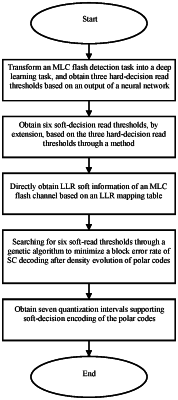| CPC G06F 3/0614 (2013.01) [G06F 3/0629 (2013.01); G06F 3/0679 (2013.01)] | 3 Claims |

|
1. A method for optimizing a Polar-RNNA quantizer of MLC NAND flash memory based on deep learning, comprising the following steps:
Step S1: transforming an MLC flash detection task into a deep learning task, and obtaining three hard-decision read thresholds based on a neural network;
Step S2: expanding six soft-decision read thresholds based on the three hard-decision read thresholds;
Step S3: constructing an LLR mapping table, and obtaining LLR soft information of the MLC flash based on the LLR mapping table;
Step S4: symmetrizing the MLC flash channel, and performing density evolution; and
Step S5:optimizing the soft-decision read thresholds based on a genetic algorithm to obtain optimal quantization intervals;
Step S2 specifically comprises:
obtaining the overlapping areas of two adjacent Gaussian distribution functions based on the MLC flash decoding curve;
sensing the overlapping areas with preset high quantization precision and sensing other areas with preset low quantization precision, that is, setting a difference between adjacent read thresholds of the overlapping area to be less than a difference between adjacent read thresholds of non-overlapping areas, so that a width W exits between each thresholds obtained by extension and an adjacent optimal threshold; and obtaining six extended read thresholds according to formula (2):
 Wherein, i=1, 2, 3, R*i ∈(B*2i-1, B*2i);
Step S3 specifically comprises: determining seven corresponding quantization intervals according to the six extended read thresholds, wherein each memory cell of MLC flash stores two bits and has four voltage stages correspondingly, a left bit is called a most significant bit and is denoted by MSB, and right bit is called a least significant bits and is denoted by LSB; and constructing the LLR mapping table, and obtaining an LLR corresponding to each bit c of a storage symbol based on the LLR mapping table;
Step S5 specifically comprises:
obtaining an optimal set {W*1, W*2, . . . , W*6} through the genetic algorithm, wherein an objective function is PB; and
 obtaining six optimal soft-decision read thresholds {B*1, B*2, . . . , B*6} according to the optimal set {W*1, W*2, . . . , W*6}, so that seven optimal quantization intervals for a Polar-code MLC flash channel are obtained.
|